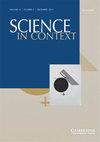Marian Smoluchowski(在他逝世十周年之际)
IF 0.5
4区 哲学
Q2 Arts and Humanities
引用次数: 0
摘要
[144]当年(1927年)9月是玛丽安·斯摩鲁乔夫斯基逝世十周年。斯摩鲁乔夫斯基的著作不仅对物理学家具有重要意义。它们也具有极高的方法论价值。由于克劳修斯、麦克斯韦和玻尔兹曼的工作,原子论在19世纪下半叶蓬勃发展,到19世纪末开始在物理学家中失宠。原子的真实性开始受到质疑,随之而来的是“克服自然科学唯物主义”的强烈冲动。4 1898年,玻尔兹曼在其关于气体运动论的经典著作的序言中遗憾地写道:“如果气体论因为一时的敌对态度而被暂时遗忘,这将是科学的一大悲剧,就像由于牛顿的权威而导致波动论那样”(玻尔兹曼1898,v-vi;Boltzmann 1995, 192 [TN])。斯摩鲁乔夫斯基关于布朗运动理论的著作为原子的实在性提供了一个光辉的新证明。正如爱因斯坦所说,从那时起,很大程度上由于斯摩鲁霍夫斯基的工作,运动理论得到了普遍认可,物理学家开始对原子的真实性产生信心。然而,这绝不是斯摩鲁霍夫斯基作品的全部意义。玻尔兹曼用他自己的工作消除了可逆过程和不可逆过程之间的形而上学鸿沟。他表明,“世界时钟不需要上发条。”本文章由计算机程序翻译,如有差异,请以英文原文为准。
Marian Smoluchowski (On the tenth anniversary of his death)
[144] September of the current year (1927) marked tenth anniversary of the death of Marian Smoluchowski.3 Smoluchowski’s works are of outstanding importance not only for the physicist. They are also of extremely high methodological value. Atomism, which thanks to the work of Clausius, Maxwell and Boltzmann, flourished in the second half of the nineteenth century, by the end of the nineteenth century began to fall into disfavor among physicists. The reality of atoms began to be questioned, accompanied by a strengthened impulse to “overcome natural scientific materialism.”4 In 1898, in the preface to his classic work on the kinetic theory of gases, Boltzmann wrote regretfully that “it would be a great tragedy for science if the theory of gases were temporarily thrown into oblivion because of a momentary hostile attitude toward it, as it happened for example to the wave theory because of Newton’s authority” (Boltzmann 1898, v–vi; Boltzmann 1995, 192 [TN]). Smoluchowski’s works on the theory of Brownian motion5 provided a brilliant new proof of the reality of atoms. Since that time, as Einstein remarks, due in large part to Smoluchowski’s work, universal recognition of the kinetic theory has been established and confidence in the reality of atoms has begun to spread among physicists. This, however, by no means exhausts the significance of Smoluchowski’s works. Boltzmann, with his own work, eliminated the metaphysical gap between reversible and irreversible processes. He showed that “the world clock does not need to be wound up.”
求助全文
通过发布文献求助,成功后即可免费获取论文全文。
去求助
来源期刊

Science in Context
综合性期刊-科学史与科学哲学
CiteScore
0.80
自引率
0.00%
发文量
1
审稿时长
>12 weeks
期刊介绍:
Science in Context is an international journal edited at The Cohn Institute for the History and Philosophy of Science and Ideas, Tel Aviv University, with the support of the Van Leer Jerusalem Institute. It is devoted to the study of the sciences from the points of view of comparative epistemology and historical sociology of scientific knowledge. The journal is committed to an interdisciplinary approach to the study of science and its cultural development - it does not segregate considerations drawn from history, philosophy and sociology. Controversies within scientific knowledge and debates about methodology are presented in their contexts.
 求助内容:
求助内容: 应助结果提醒方式:
应助结果提醒方式:


